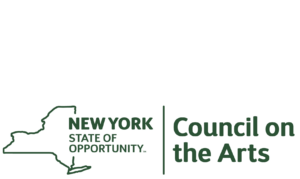My Heckscher Story
Your story is our story, and we want to celebrate it!
The Heckscher Museum commemorates the fascinating people, events, and art that define the Museum’s first 100 years. Tell us about your own special moment / memory at the Museum! Share your story and photos here, and you may be featured below and on our social media channels!
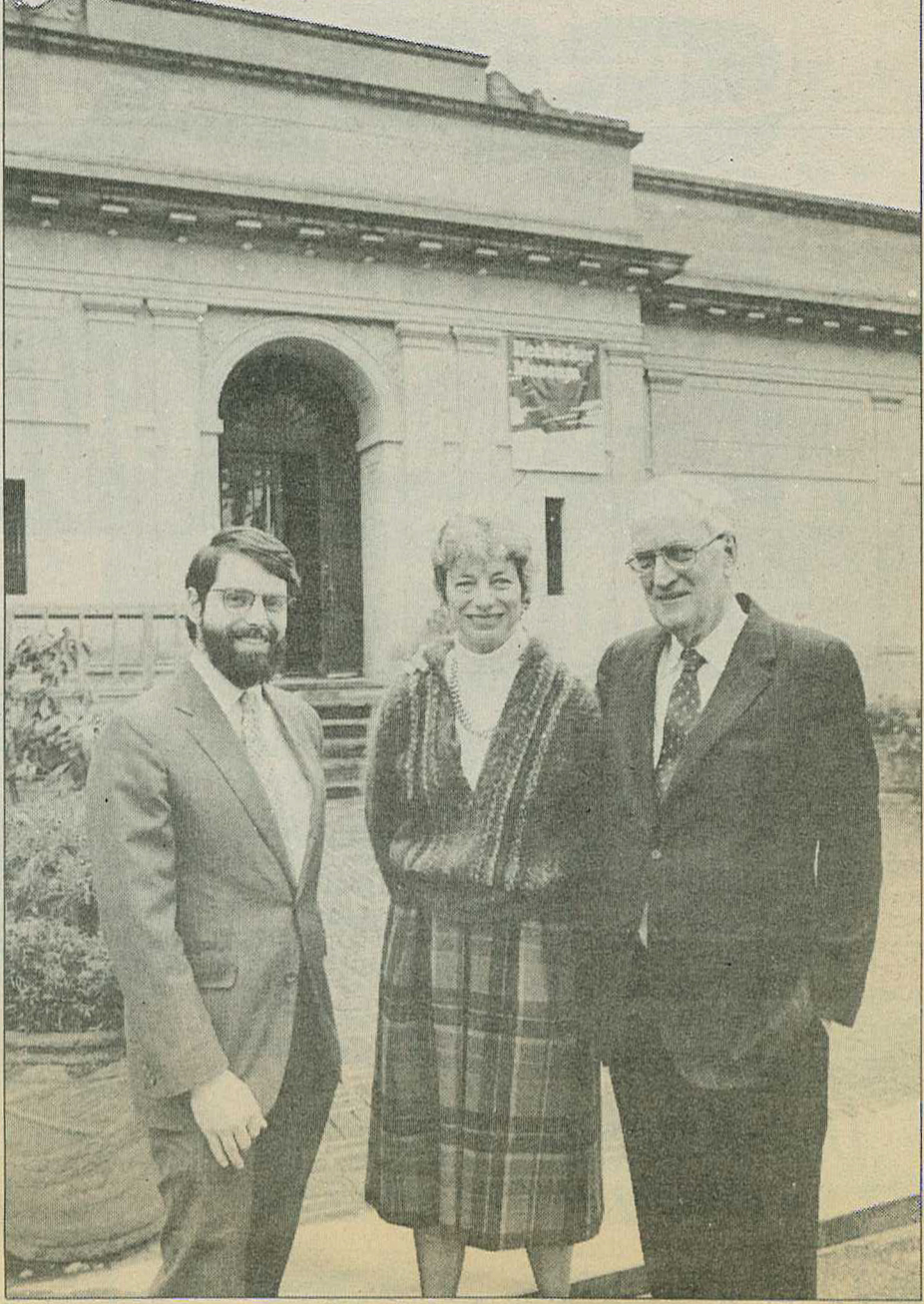
John Coraor, Ph.D.
Former Museum Director, Current Trustee & Interim Director
“Undoubtedly every person who experiences the Heckscher Museum of Art comes away with a uniquely personal perception of what the Heckscher means to them. For some visitors it is an opportunity to see new and interesting artwork on exhibit. For others it is a place to visit old favorites from the Museum’s permanent collection. Some patrons may be more interested in learning new things at the Museum’s public programs, while many are attracted to the social ambiance of its exhibition openings and special events. For an artist whose work is on exhibit, the Museum may be an important source of validation, generating feelings of pride and accomplishment. Indeed, all of these are, and should be, elements of the Heckscher experience.
For me personally, however, as someone who had the privilege to serve as the Heckscher’s Executive Director for 12 years from 1988-2000, the Heckscher shall always be a place of collective accomplishment by a team of committed people. It is where docents, other volunteers, Trustees, staff, artists, collectors, program presenters, members, and donors each have an important role in collectively making the Heckscher ‘a leading source of artistic inspiration for Long Island and the region.'”
Photo (left to right): John Coraor, Robin Hadley, Chair of the Board of Trustees, & John W.B. Hadley.
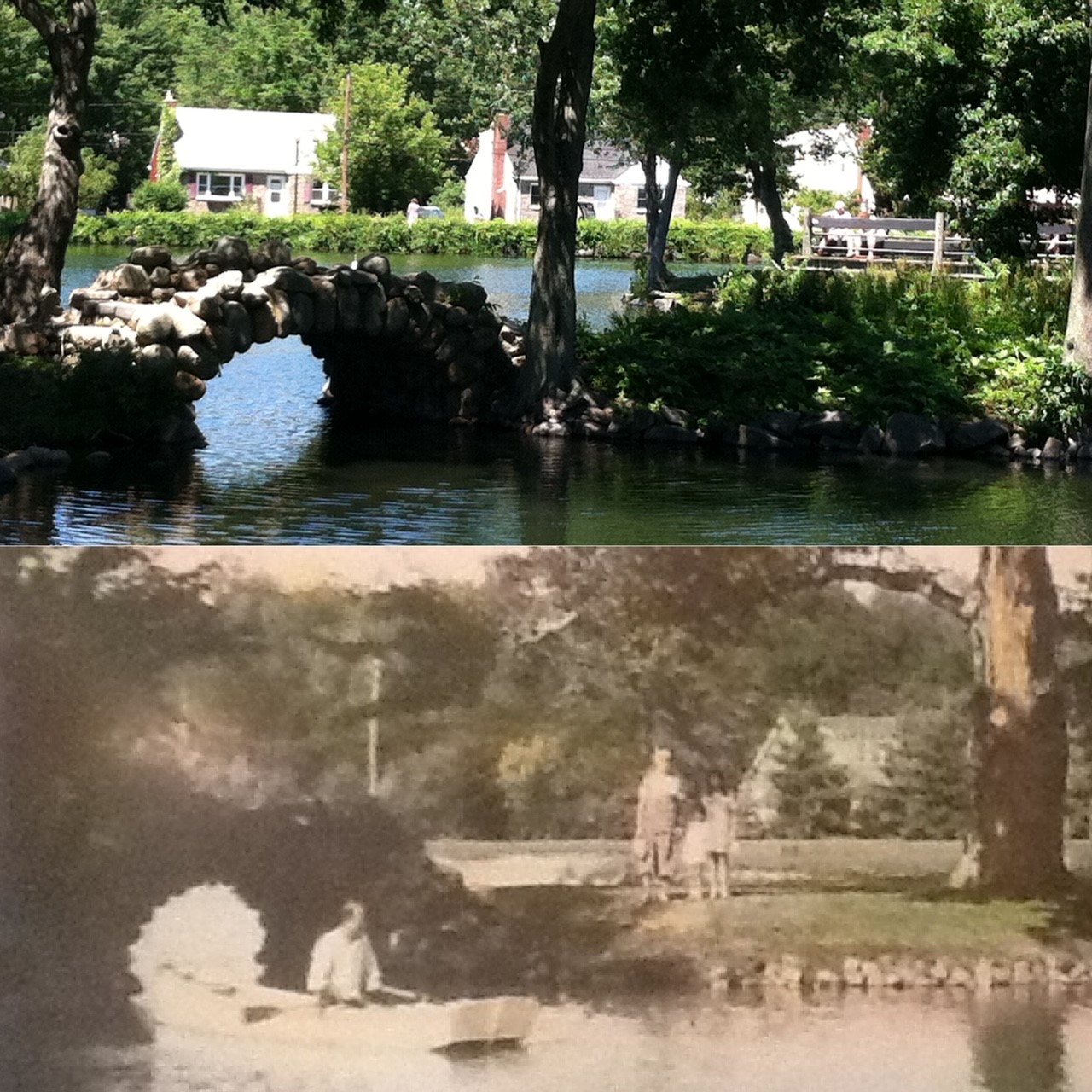
Bonnie Nass-Dunbar
Community Member
“My Mom, Ottilie Strakosch Mead, had an old photo of herself, her Mom and Dad (Lillian and Herman Strakosch), and little brother, John, taken in Heckscher Park! A few years ago, my husband and I drove in from our home in Setauket, and took a photo of the same place the 1931 photo had been taken nearly 90 years ago! I personally grew up in Huntington Beach, so as a child would visit the park every so often to see the wildlife! The park is quite different from how I remember it, however, it is still a lovely place to visit.”
Photo (top to bottom): Heckscher Park, Huntington, today. Ottilie Strakosch Mead, her Mom and Dad (Lillian and Herman Strakosch), and her little brother (John Strakosch) pose in Heckscher Park, Huntington, 1931.
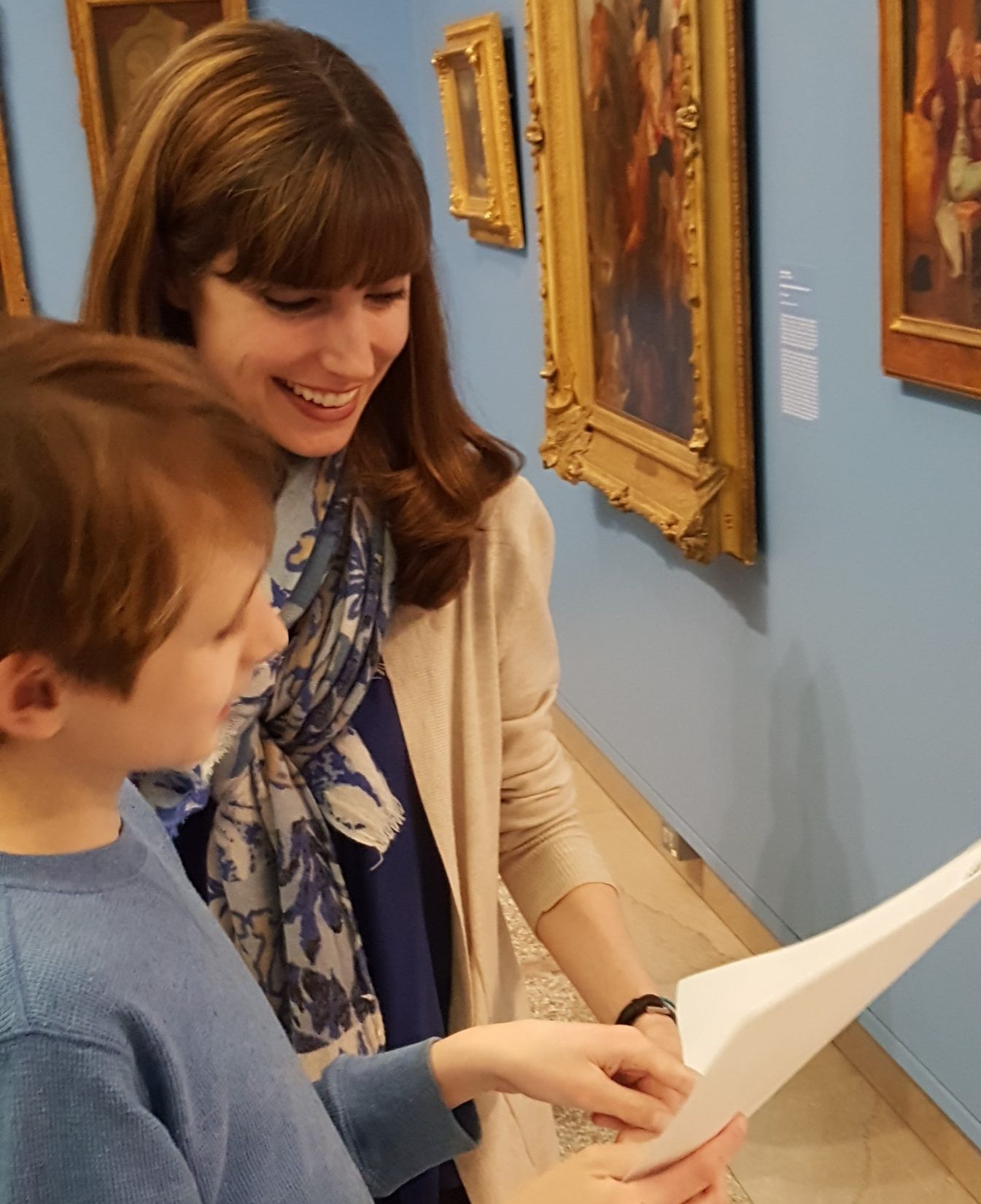
Tami Wood
Museum Educator and Community Member
“I’m going to take you back to the sticky August afternoon when my then two year old son and I first fell in love with the Heckscher Museum. He had been playing for hours on the hot playground and we both needed a break, so in search of some quiet and AC, I brought him to the Museum. There we were given paper and pencils and we were encouraged to sit on the floor to draw, which we did happily. We felt truly welcomed, like it was our Museum.
Now that my son is 13 and my daughter 11 and we were (until a few months ago) racing between sports practices and music lessons, playdates and birthday parties, we still visited the Heckscher for a respite, to slow down and re-connect to art and each other. We feel so fortunate to have a Museum right in our backyard, one we can pop into whenever we like. But things have changed at the Heckscher in the past decade, and for the better. We’re not just given pencils and paper. Now we can spend a whole afternoon going on a gallery scavenger hunt, or making a collage based on a featured artwork, or, of course, using the Digital Action Painter. A lot of thought has been put into how to attract and engage families and with much success.
My relationship with the Heckscher has changed too. As an educator at the Metropolitan Museum of Art, I approached the Heckscher eight years ago about offering more family programs. From my years teaching at the Met, MoMA and other New York City museums, I know the difference museums make in the lives of young people. Museum experiences encourage curiosity, develop critical thinking, boost language development, and inspire children to dream of possibilities that are beyond what they already know. I wanted this for local families, and the Heckscher wanted it too.
It was then that Heckscher Family Hour was born. Family Hour is a program geared toward families with children ages 5 to 10. On select Sundays, I lead these families on an interactive tour of the Museum’s latest exhibition. We have conversations, play gallery games and make our own art. Together we look at Cornelia Foss’ painting “Ominous Sky” and talk about what makes it so ominous. We pose like figures in Norman Rockwell’s illustrations. We compare realist and abstract landscapes, 2d and 3d figures. We imagine what would happen if Claus Oldenberg’s “Flying Pizza” were real—where would it go, what would it do?
My children’s relationship with the Heckscher has changed too. Along with other tweens/teens who were past Family Hour participants, they are now Heckscher Youth Ambassadors, leading their own Museum tours at public events. I am thrilled that they now have the opportunity to welcome others to the Museum that has always welcomed us.”
Photo: Tami Wood and her son at The Heckscher.
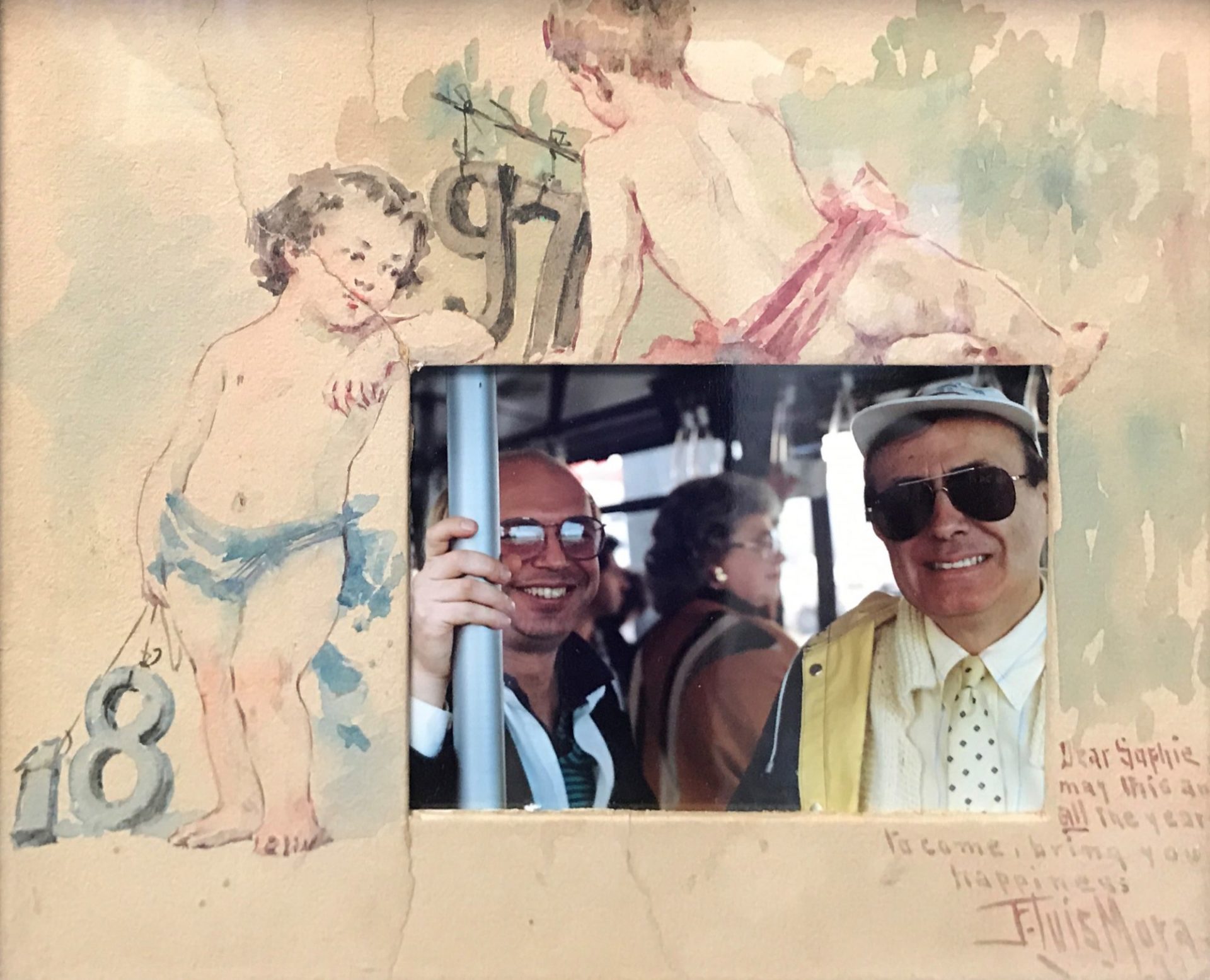
D. Frederick Baker
Collector, Philanthropist
An Old Rusty Mosaic Table
Any story relating to the early years of the museum, must include its intrepid and redoubtable director, Eva Gatling. She was a force of nature and from the beginning set about creating an art museum of significant importance to the community. She insisted that the museum acquire works by prominent artists, and in doing so she enlarged the membership base to include knowledgeable collectors and likely benefactors. She also arranged for a grant from the Stebbins Family Foundation to hire an art history graduate student as a summer intern. The second year recipient was Ron Pisano, graduate student at the University of Delaware. From the beginning he and Eva developed a close working relationship, mutual respect and a long enduring friendship.
Around the same time, Eva met Mary Rehm who showed up at the museum with a problem—she was Helen Torr’s sister and upon Helen’s death Mary was instructed to take all of her paintings “…and get rid of them.” Seems unbelievable, as Helen has now finally been accorded her rightful place in the history of American art of the early 20th century. Eva, of course, dissuaded Mary from following Helen’s instructions, and likely Mary wasn’t inclined to follow them anyway. But she needed advice and, hopefully, an advocate—Eva being the most logical person around. As a result, the museum mounted a retrospective of the work of Helen Torr, in 1972—the first exhibition of her work since a joint exhibition with her husband, Arthur Dove, at Alfred Stieglitz’s gallery, “An American Place,” in 1933. Still there was the problem of where to store Helen Torr’s paintings and drawings, solved by taking them to Eva’s house in Huntington. Ron and I believed this offered the best opportunity to catalogue the collection, which involved our purchasing an estate stamp, and recording the list of Torr’s known work. And along with this work came an old rusty metal and mosaic table, which Dove had used as an easel of sorts for painting watercolors when living in their little cottage on Titus Mill Pond, Centerport (now owned by the museum and on the list of Historic Artists’ Homes and Studios). Mary wanted Eva to have it, and when Eva retired and moved to Alabama, she gave it to us. And after several years, we gave it to the Heckscher Museum. It is the only piece of furniture saved from the last home of Arthur Dove and Helen Torr.
Image: Photograph of Ron Pisano and Fred Baker in Casablanca, Morocco in 1993, taken by Deborah Johnson; Watercolor mat (1897) by F. Luis Mora (1874-1940).
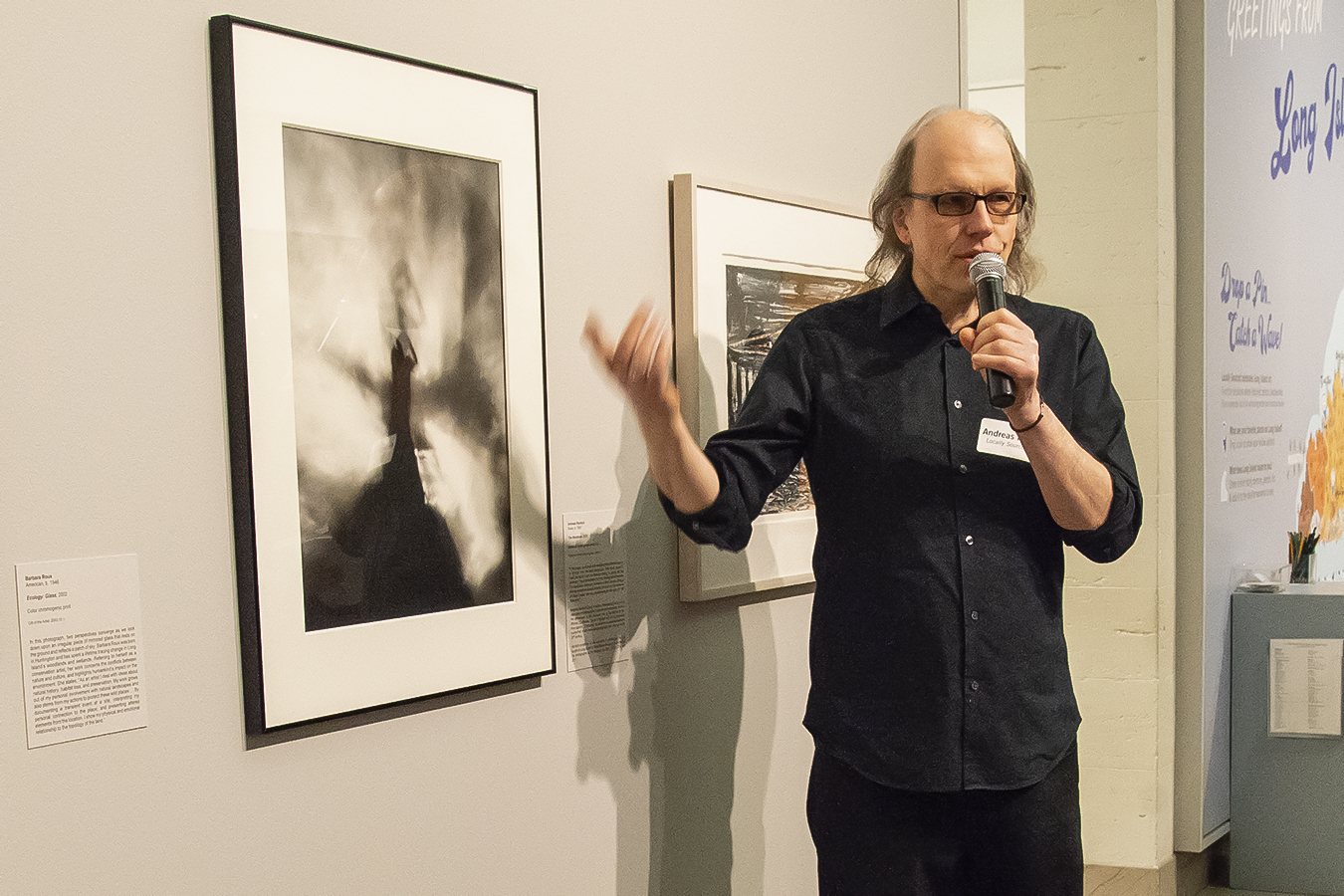
Andreas Rentsch
Artist
“In 2003, my wife, the artist Helen Rousakis, and I were looking to relocate from New York City, where we lived for many years. Having a newborn son, we needed more space. During one of our house searches, we explored Huntington and visited the Heckscher Museum of Art for the first time. To our astonishment, they had an exhibition of Anne Brigman’s work, a pioneering Pictorialist photographer from the beginning of the 20th Century who did nude self-portraiture in the landscape. As I had done similar work at the beginning of my career, she was always an artist that I respected and admired. After that, we were sold on living in Huntington and bought a house just half a block from the museum. We have forged close relationships with the directors, curators and the staff over the years. We both have exhibited our work numerous times at the museum and my art is now part of their collection. We proudly bring our friends to see the latest exhibitions and highlight the important place the museum represents in Long Island’s cultural and artistic landscape.”
Photo: Andreas Rentsch discussing his work on view in the Museum’s exhibition Locally Sourced in 2019.
© Copyright Helen Rousakis.
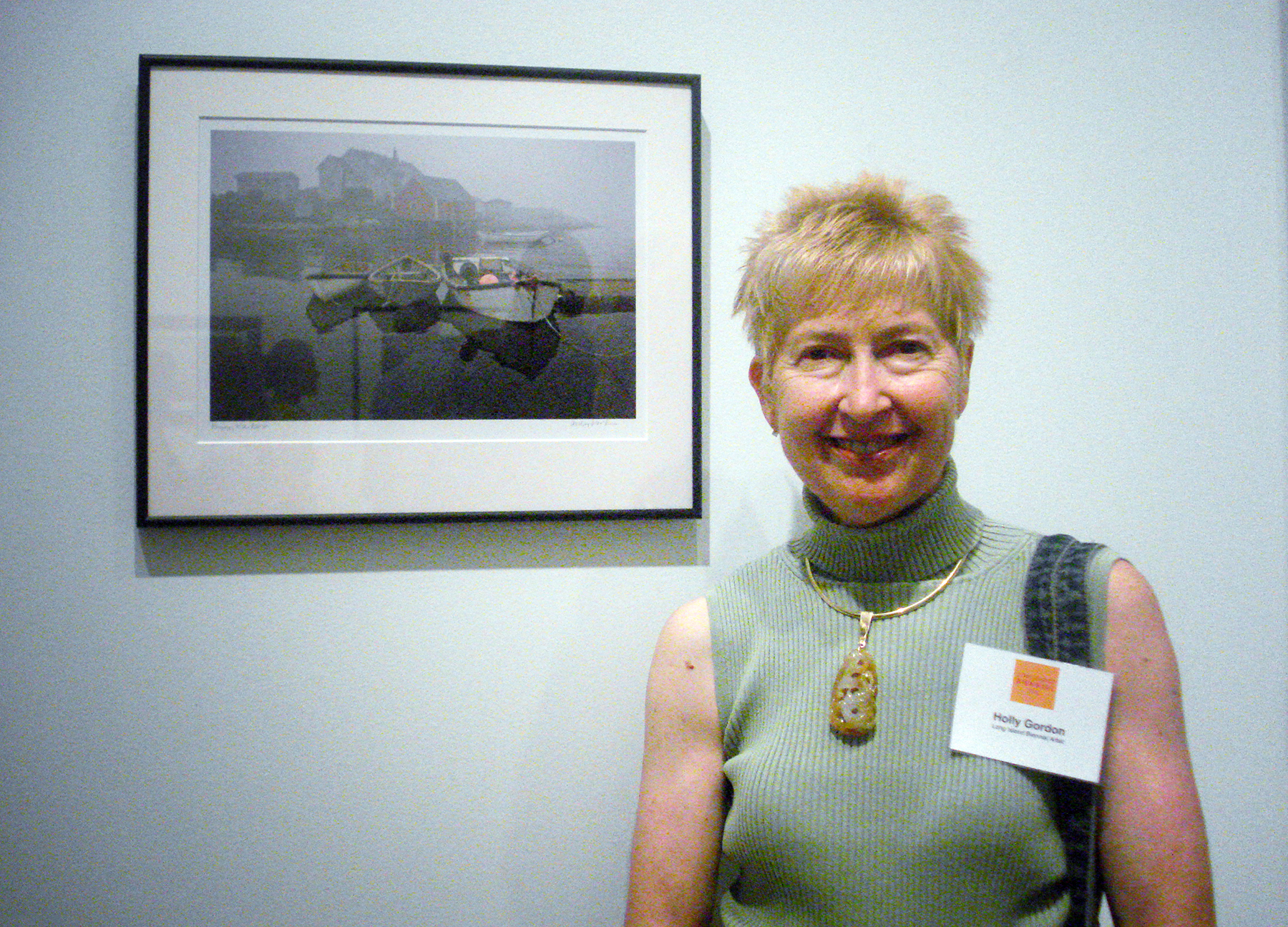
Holly Gordon
Artist
“The 100 Year Celebration of The Heckscher Museum of Art marks a time to reflect on the past and project to the future. The uncanny connections between the Heckscher and me go back for decades. Two books, of which both the Heckscher and I are integral parts, emerged during this 100-year celebration, and pose an intriguing question: is it destiny or serendipity that brings us together?
Intertwining roots were establishing themselves long before there was conscious realization. As a former art teacher, I brought my classes to the Heckscher to expand and enrich their art experiences, knowledge and lives.
In 2010 my Foggy Harbor photograph was part of the first Heckscher Long Island Biennial, and I was one of five exhibiting artists selected to discuss my creative process for the Viewpoints event.
The publication of Parallel Perspectives: The Brush/Lens Collaboration, a visual memoir art book erupted from the North Shore Long Island landscape and irrefutably intertwines me to the Heckscher Museum of Art through the connection of Arthur Dove and Helen Torr. When watercolorist Ward Hooper and I were brought together in 2014, our meeting grew into an extraordinary collaboration.
Our relationship and experiences paralleled so many of early 20th century abstract artists, Arthur Dove and Helen Torr, who lived and loved here 75 years earlier. Was it destiny or serendipity that brought us together?
Ward knew of their cottage and in minutes navigated me to it. Our link to the Dove-Torr past became concrete. Ward and I each explored the location to create our personal interpretations of the cottage; but best of all, Ward had photographed me photographing the cottage and made me a painting that memorializes the moment. I renamed my Cold Spring Harbor Pond image, Indian Summe, and it began to dawn on me that we might be doing something greater than ourselves. Both Dove and I shared a spiritual connection with Nature. He was in the forefront of abstract art. Technology is changing photography as we know it my Photo-Liminalism process is part of the change.
One year after discovering our Dove-Torr connection, neighbors, who had lived across the street from Arthur Dove’s son Bill and granddaughter Toni, saw our exhibition at MacArthur Airport and wrote us a note. Destiny or serendipity?
Valerie A. Balint, author of Guide to Historic Artists’ Homes & Studios contacted Michael Schantz to acquire photographs of the Dove-Torr Cottage for her book. Knowing of my connection, he invited me to meet him at the cottage and put me in touch with Balint. My photographs are featured in this book.
Is it destiny or serendipity that brings us together at this juncture is something for historians to ponder and write about in the next chapter of art history; but it is irrefutable that this journey with no predetermined destination brings us together now. I am thankful for being invited to share my story with The Heckscher Museum of Art.”
Learn more about Parallel Perspectives: The Brush/Lens Collaboration
Learn more about the Dove/Torr Cottage
Photo: Holly Gordon alongside her artwork Foggy Harbor, on view in the inaugural 2010 Long Island Biennial.
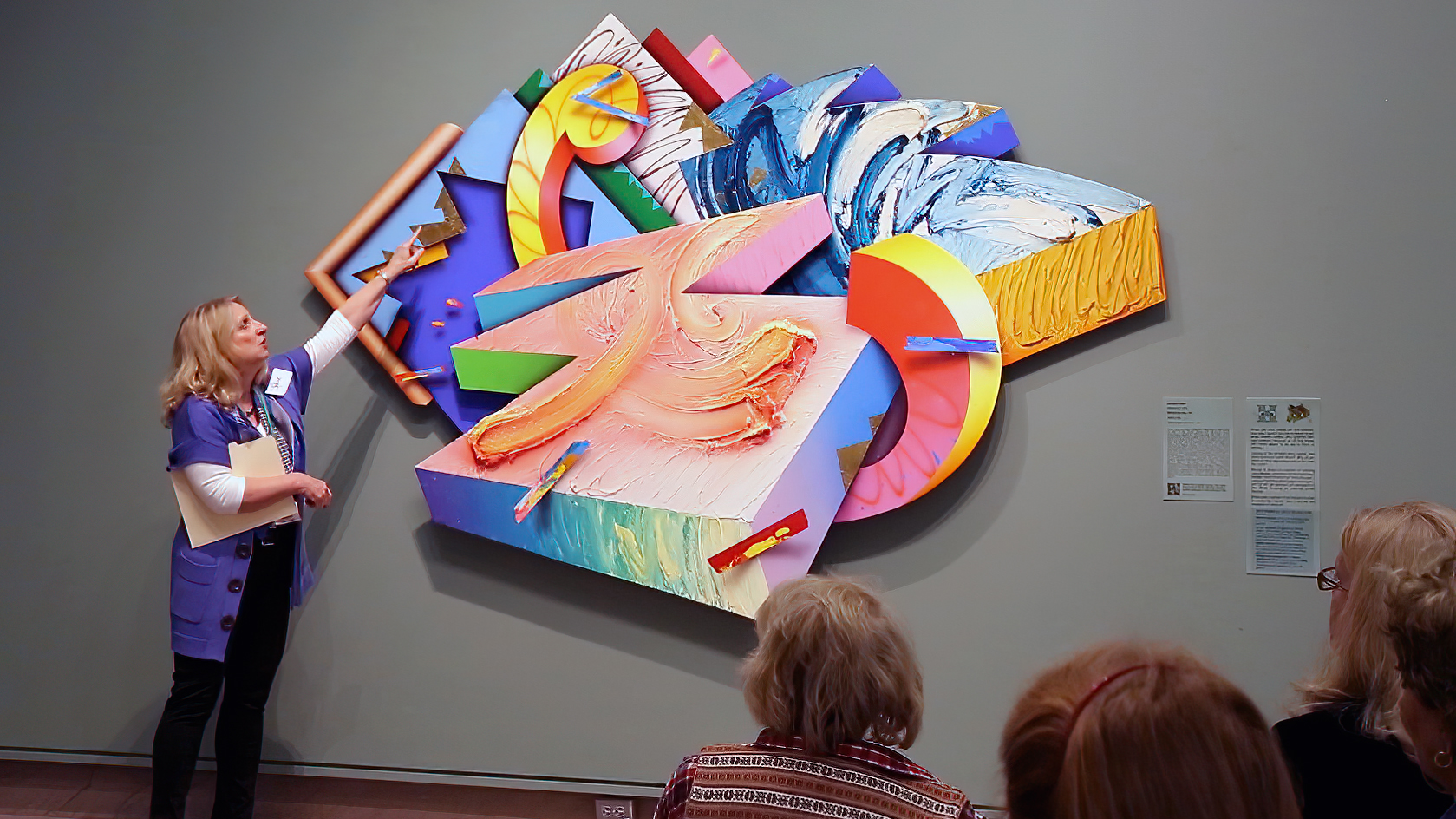
Sue Peragallo
Docent
“Serving as a docent at the Heckscher Museum has given me an enormous sense of joy! Over the past 15 years I have given lectures, spoken with visitors as ‘Docent in the Gallery,’ and brought exhibitions to local assisted living facilities through slide presentations. Exploring the museum’s amazing collection and exciting exhibitions with their curators and education staff has been horizon-expanding. Especially rewarding has been the sharing of that knowledge with museum visitors, while exchanging our insights and observations. Indeed, the best part of being a docent is meeting and talking and sharing with the wonderful staff, docents, and visitors!”
Photo: Sue Peragallo leads a discussion of George D. Green, Minding Dog Rag, 1987, Mixed media.
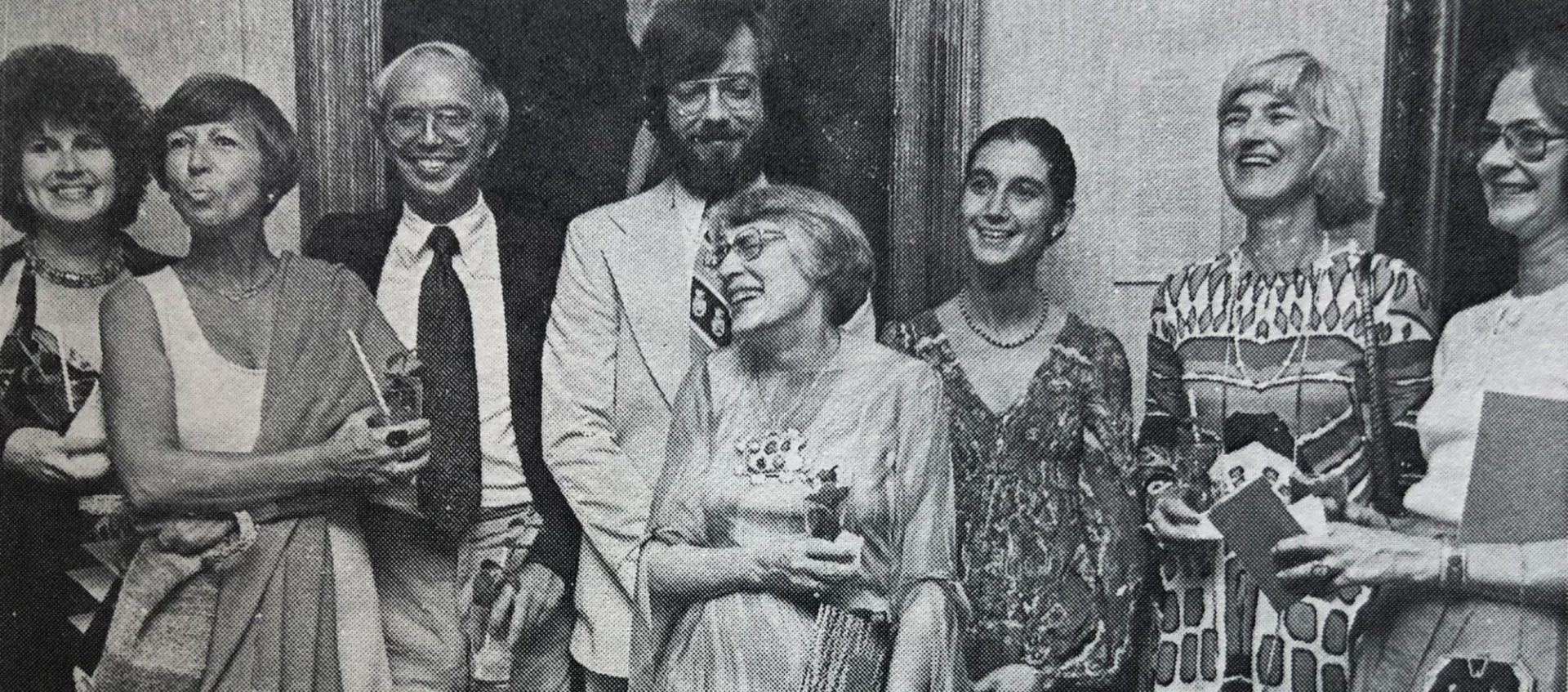
Carol Forman Tabler
Ph.D., Art Historian
“My connection with the Heckscher Museum began forty-six years ago when I was hired by then director Eva Gatling to do the research and writing for the European section of the collection catalogue, published in 1979. Eva always shared her ideas and encouraged me to make my own decisions. She was my muse. I also had the great pleasure of collaborating with fellow art historian Ronald G. Pisano, who wrote the American section of the catalogue and became my dear friend, mentor, and inspiration. Although I didn’t realize it at the time, my research for the Heckscher catalogue not only launched my professional career but also my life’s work by introducing me to Antoine Vollon, one of several French nineteenth-century artists in the collection. Ultimately, my discovery of Vollon, who, I felt, deserved to become better known, led to a doctoral dissertation at the Institute of Fine Arts, NYU, on the subject of his landscape paintings, and I am still engaged in the pursuit of research, writing, and discussion about this fascinating artist. Over the years, while I was teaching graduate and undergraduate courses at LIU/Post, the museum asked me to guest-curate two exhibitions, Realms of Resonance; Painting and Drawing in Nineteenth-Century France (2002) and Illuminations: Images of Landscape in France, 1855-1885 (1990), the latter traveling to two additional venues. Heartfelt thanks to the Heckscher Museum where I currently serve on the Collections Stewardship Committee.”
Photo: Eva Gatling surrounded by Museum associates in 1977 (left to right) Carol Forman Tabler, Ruth Solomon, Ron Pisano, Bill Titus, Elizabeth Boas, May Davis Hill and Sue Kohler.
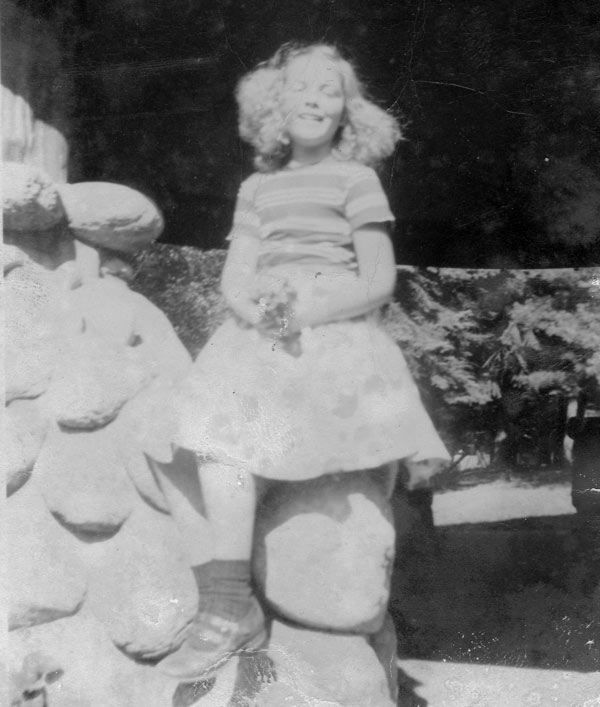
Barbara Roux
Artist
“I was born at Huntington Hospital in 1946, which I imagine you can see from the south hill of Heckscher Park. Most of my life has been spent in Huntington. As a child my mom took me to Heckscher Park regularly on the bus from Huntington Station where we lived. I recall my rambles through the park grounds, walking out to the island in the pond, calling out hello loudly in the rubble stone gazebo by the pine grove, sitting under the shade of the great Norway maples by the playground. After my ramble we sometimes went into the cool, peaceful sanctuary of the museum.
The Heckscher Museum was my Metropolitan Museum of Art and it always will be. There I had my first encounter close up with paintings that I thought were beautiful and powerful. There was a painting of a country scene in autumn that was aglow with orange. It was by Thomas Moran and titled The Woods in Autumn. I got to know this artist’s work of Hudson River School fame as a graduate student in art at Hunter College decades later. There was also a night scene of a full moon over trees I loved by Ralph Blakelock titled The Poetry of Moonlight. And I had a fascination for a huge painting, Embarkation Maneuver by Berne-Bellecour. This scene of soldiers waiting to board a train to take them to battle in the Franco-Prussian War stays with me. They have elegant red and white uniforms and there is such apprehension of what is going to happen to them with a dark foreboding sky. I always felt I could walk into it. Maybe it was because of my childhood connections to war stories. My dad had been in World War II and my great grandfather fought in the Civil War in the Union Army.
When I was older I visited the museum often. I was very drawn to James Scudder’s Afternoon at Rocky Point. This painting was of a scene I knew well, Target Rock in Lloyd Neck. I visited that area with a friend who lived on the salt marsh next to that spot. In the 1970s when it became popular as a wildlife refuge it was my favorite haunt. The place inspired much of my work as a college student and for years to come. I still have a museum postcard of that painting.
In the late 1990s, I began a professional relationship with the Heckscher. Eight of my artworks are now part of the collection, and they are often on view in exhibitions. I have been delighted to see my ecologically-inspired work in the company of my favorite 19th-century landscape paintings that I recognized from my visits in years past. August and Anna Heckscher dedicated the Heckscher Museum and park ‘to the little birds who migrate, and to the children who fortunately do not.’ I am happy to say I am one of those who did not migrate.”
Photo: Barbara Roux at the “rumble stone gazebo” in Heckscher Park, 1950
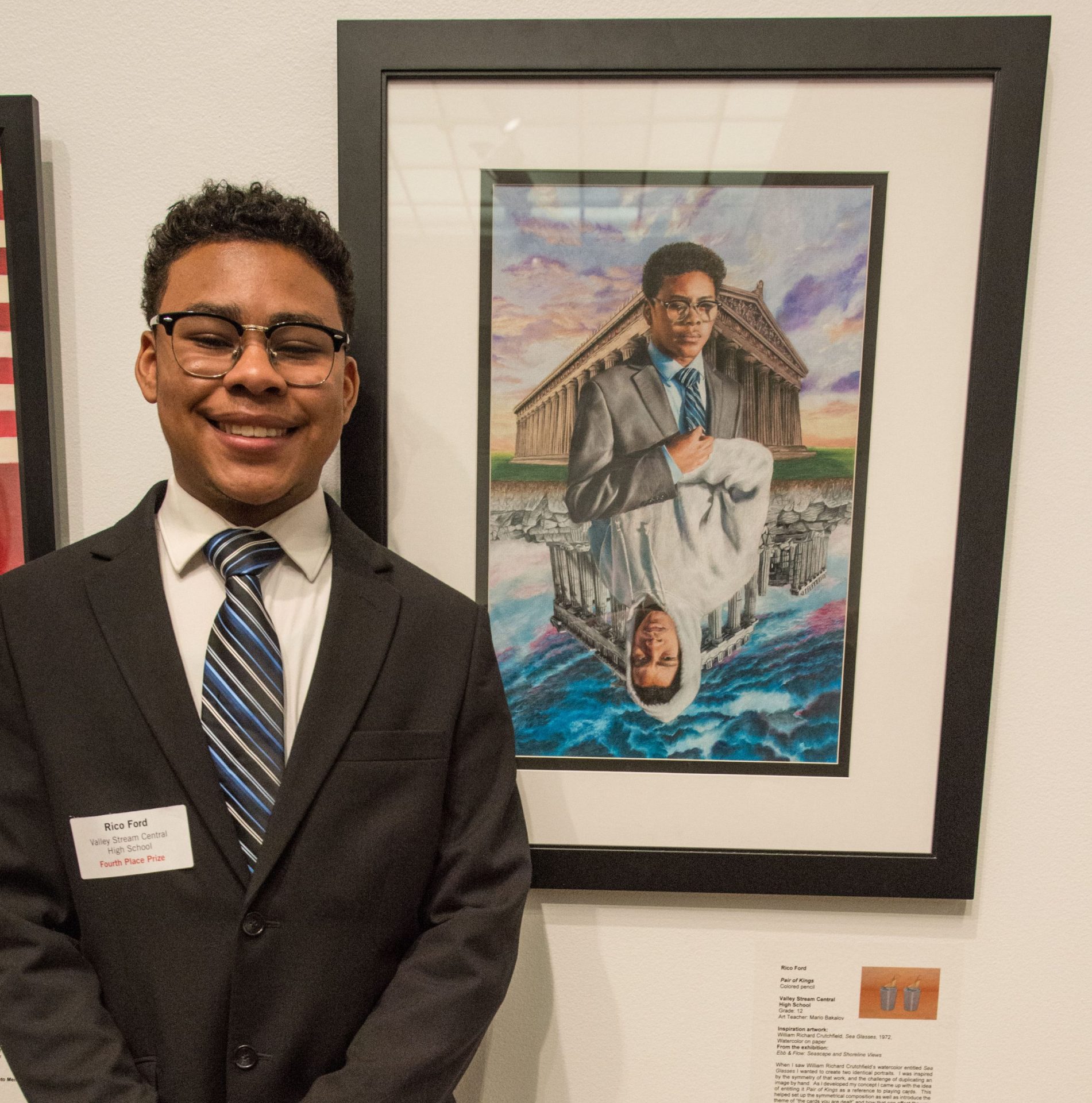
Rico Ford
Art student
“In 2018, I had the honor of being the Long Island’s Best 4th place award winner, as well as the Grumbacher Visitors’ Choice. My experience with the museum has changed the way I see myself in this world. I was never exposed to art museums, or knew any artists like me. The Heckscher allowed me to meet artists my age from all different backgrounds. To this day in college, I still meet people who recognize my work, and made friends with students who participated in the show.”
Photo: Rico Ford alongside his award-winning artwork in Long Island’s Best 2018.
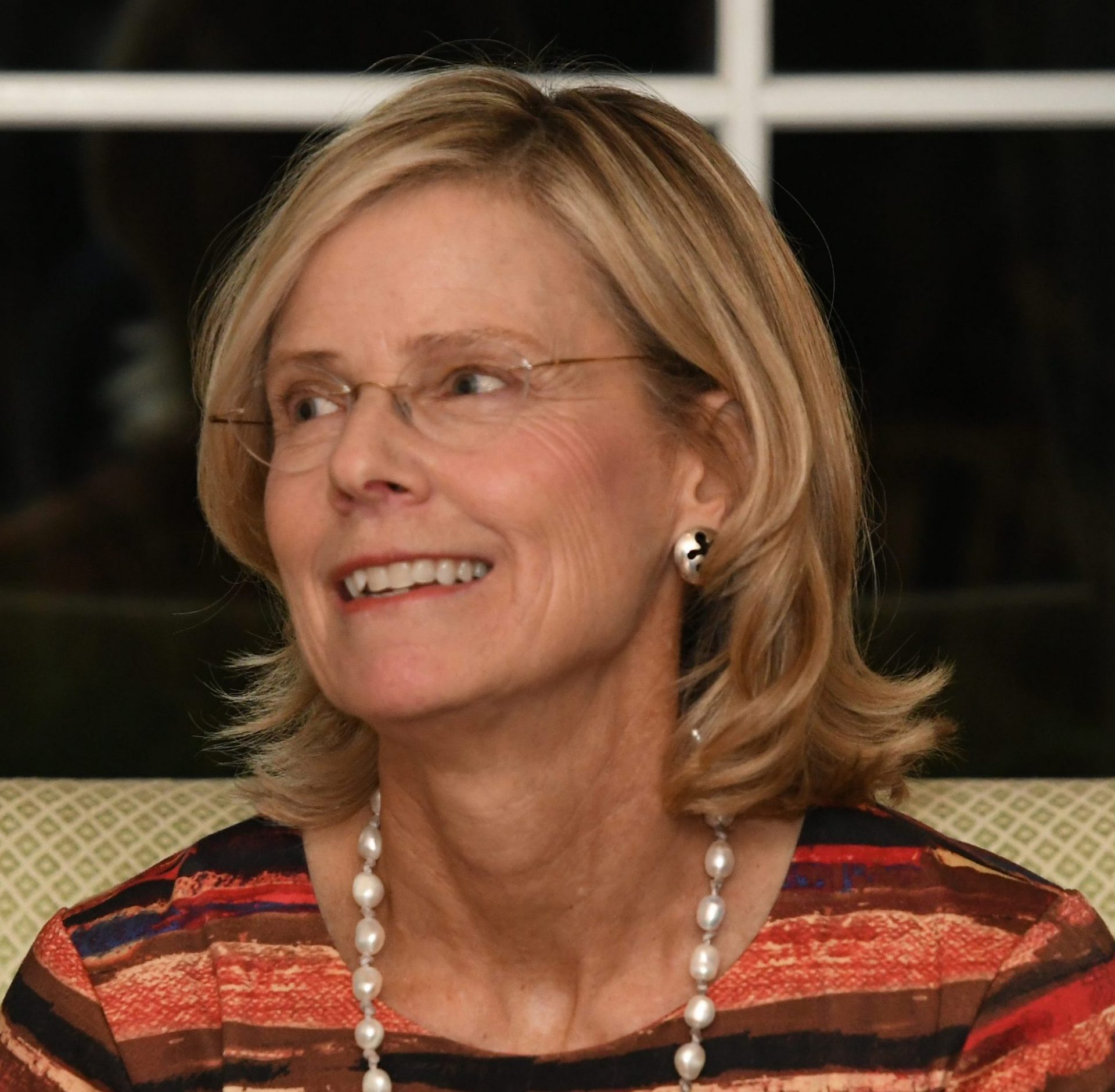
Laura Powers Swiggett
Community member
“I have a vivid memory of standing in the Heckscher about 25 years ago. I was in front of an Esteban Vicente painting of such sublime beauty that for a minute, everything around me dissolved. I understood more fully what my mentor, Stan Brodsky, had been helping me discover. It aroused my senses, lifted my spirits, and expanded my boundaries. Art gives me a language for tapping into things beneath the surface, for which I would otherwise not have a vocabulary.”
Photo: Laura Powers Swiggett
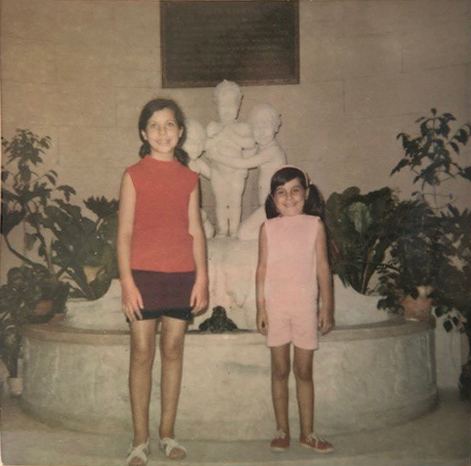
Lauren W. Summers
Docent
“Here we are, Lauren and Rissa Winters, enjoying another wonderful day at The Heckscher Museum and park in August 1967. While growing up our frequent visits to the park shaped our lives in so many ways. The beauty of the pond and bridges, the wonders of the museum, and the evenings of music under the stars were all integral to our happy family. Today we are both still residents of Huntington, and still frequent this lovely park. I am delighted to be one of the new docents at the Heckscher Museum, and have the great privilege of sharing this gem with our many valued visitors.”
Racing up the stairs
A joyous return
To walls of art
Who call to me
The Poetry of Moonlight whispers
While Youth Eternal’s frog teases
Bold colors laugh
And sculptures play in space
Tulips on arrival
Geese above at dusk
Worry not
I’ll be back
It’s my museum.
Photo: Lauren W. Summers (right) and her sister Rissa in the Museum in 1967.
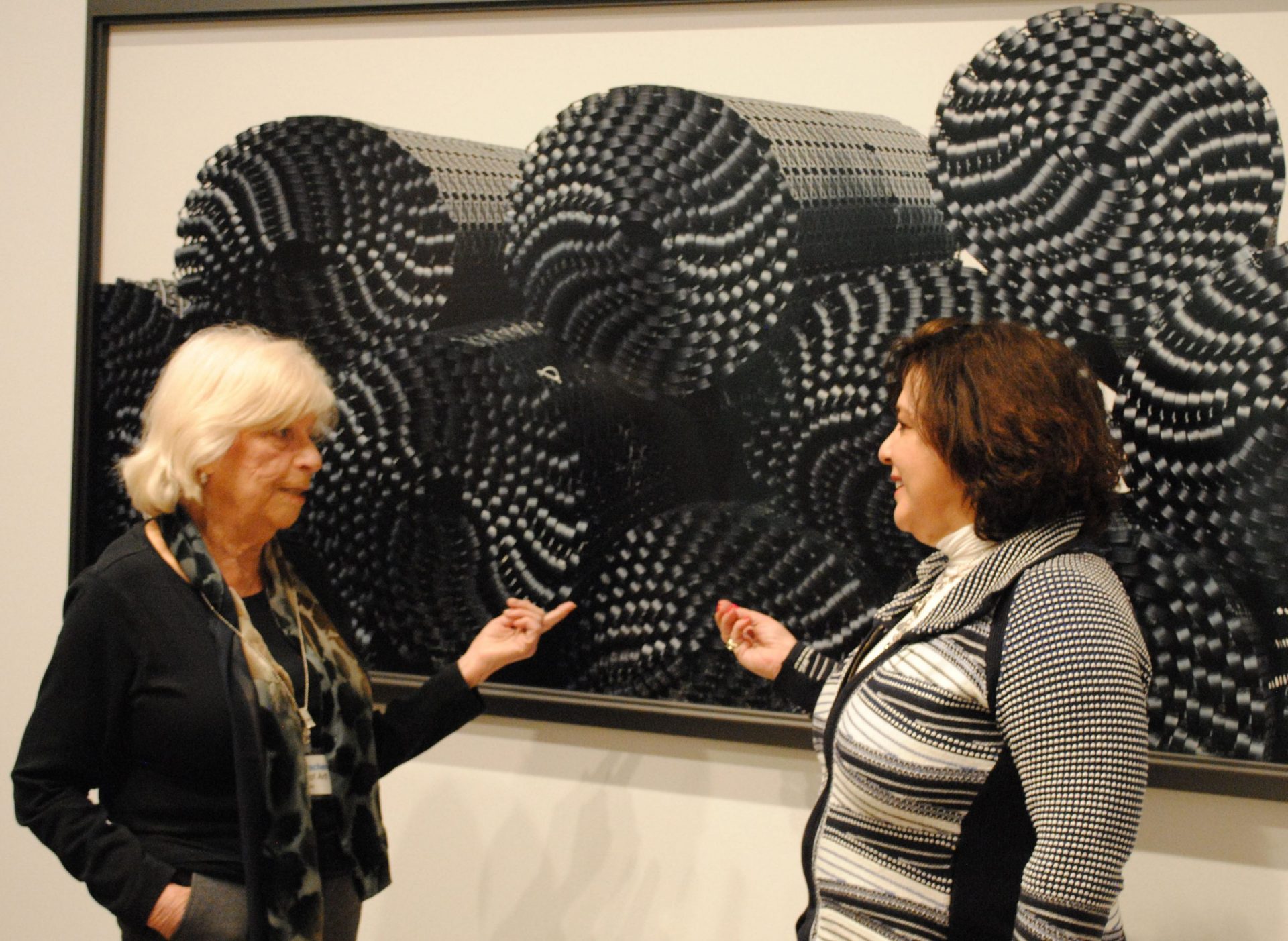
Molla Gary
Docent volunteer
“As a docent, I love talking to people and telling them about the artwork. I like to talk about [George Grosz’s Eclipse of the Sun]. I enjoy it when I am talking to a group and they themselves say, ‘It’s relevant today,’ and begin to share ideas with others in the group. It’s very exciting!”
Photo: Molla Gary (left) speaks with a visitor about artwork in an exhibition of artist Jan Staller’s work.
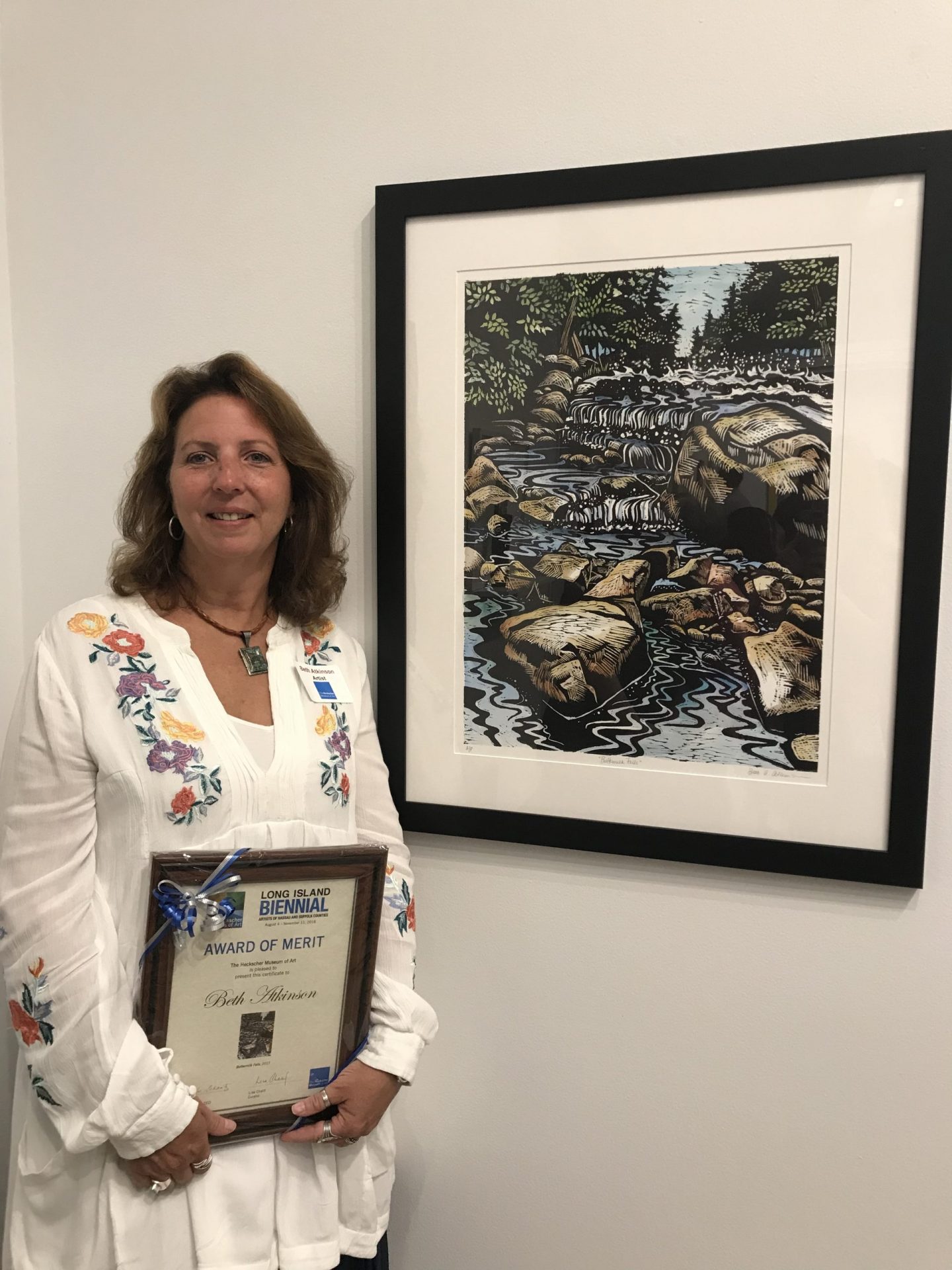
Beth Atkinson
Artist and retired art teacher
“As an art teacher at Hicksville High School, I brought my students to The Heckscher Museum for more than 20 years for Long Island’s Best: Young Artists at The Heckscher Museum. Seeing their [own] artwork hung in such a prestigious museum is overwhelming for students. Then, to see their parents’ reactions—that is worth everything to me as a teacher!”
Photo: Beth Atkinson alongside her artwork in the Museum’s Long Island Biennial 2018.
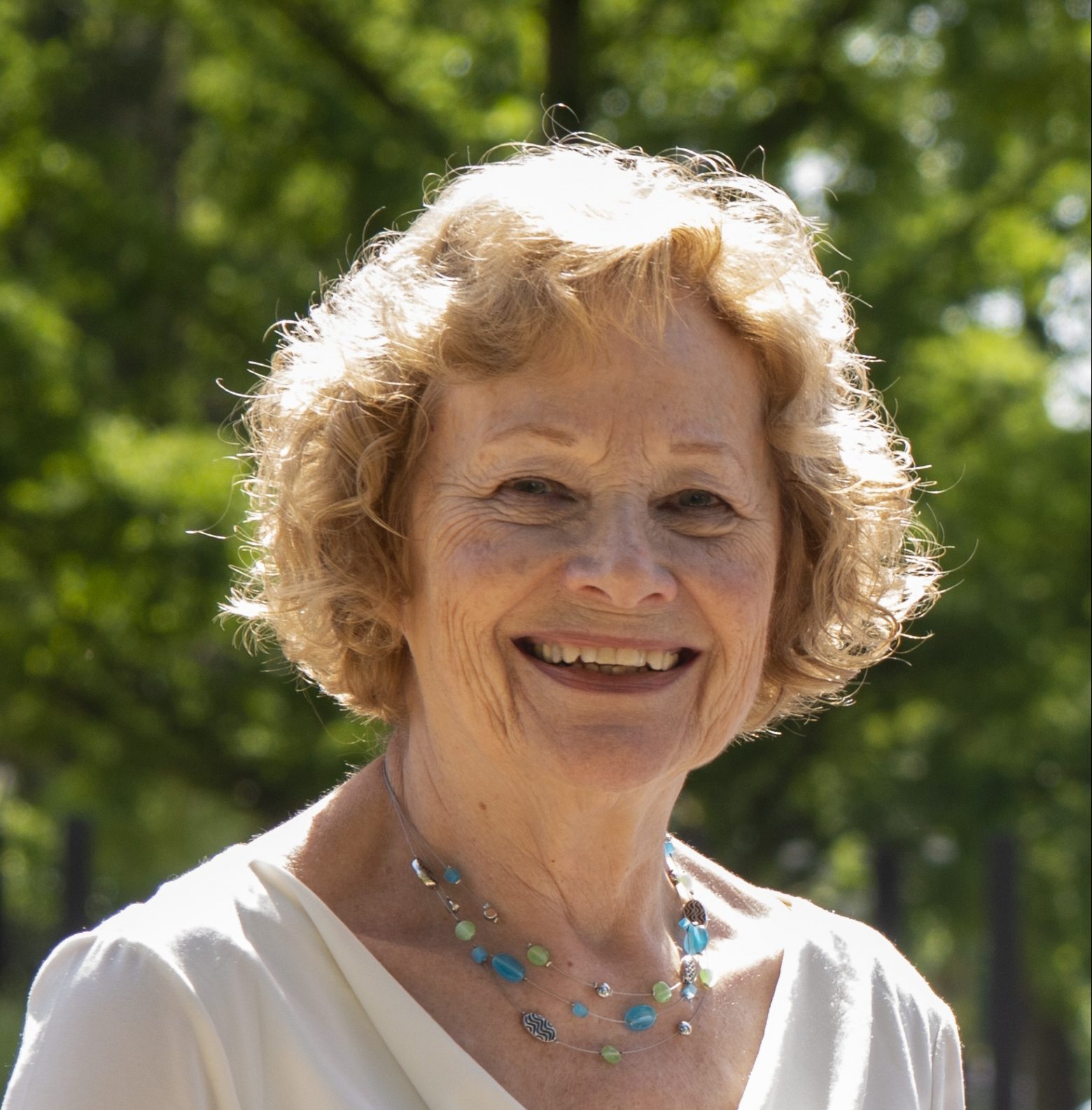
Jeri Weitman
Musician, Museum volunteer, former music teacher and Museum staff member
“In the year 2000, I was hired to work at the Heckscher as Coordinator of Public Programs. That year the arts world celebrated American composer Aaron Copland’s 100th birthday. Copland was a favorite of Beth Levinthal, Interim Director of the Heckscher at the time. Her vision of creating a multidiscipline program linking the visual arts and Copland became Aaron Copland’s America, the extraordinary exhibit that introduced me to the limitless possibilities of making connections in the arts. With this all-encompassing model for future exhibitions, I had the privilege of working with the fabulous Education Department staff for the next six years, planning and implementing programs to enrich the understanding of the works on view. During that time, I met numerous musicians and artists, Lukas Foss, David Amram, and Larry Rivers, to name a few, and hosted countless concerts, poetry nights, jazz brunches, artist studio tours, and children’s programs. It was an exciting and stimulating time, full of wonderful memories for me!”
Photo: Jeri Weitman in Heckscher Park.

